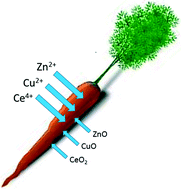Themed collection Environmental Science: Nano 2016 Most Downloaded Articles

Recent advances in halloysite nanotube derived composites for water treatment
Halloysite nanotubes (HNTs) are naturally occurring clay mineral with nanotubular structures and have found increasing potential applications in industrial fields.

Environ. Sci.: Nano, 2016,3, 28-44
https://doi.org/10.1039/C5EN00149H
Impacts of metal-based engineered nanomaterials on soil communities
A comprehensive review of the effects of metal-based nanoparticles on trophic groups, interactions, ecosystem functions and biodiversity of soil communities.

Environ. Sci.: Nano, 2016,3, 506-533
https://doi.org/10.1039/C6EN00007J
Environmental processes and toxicity of metallic nanoparticles in aquatic systems as affected by natural organic matter
The key roles of NOM affecting environmental processes and toxicity of MNPs in aquatic environments are discussed and presented.

Environ. Sci.: Nano, 2016,3, 240-255
https://doi.org/10.1039/C5EN00230C
Nanoparticles in road dust from impervious urban surfaces: distribution, identification, and environmental implications
Nanoparticles (NPs) resulting from urban road dust resuspension are an understudied class of pollutants in urban environments with strong potential for health hazards.

Environ. Sci.: Nano, 2016,3, 534-544
https://doi.org/10.1039/C6EN00056H
Effects of crystallite size on the structure and magnetism of ferrihydrite
The structure and magnetic properties of nano-sized (1.6 to 4.4 nm) ferrihydrite samples are systematically investigated through a combination of X-ray diffraction (XRD), X-ray pair distribution function (PDF), X-ray absorption spectroscopy (XAS) and magnetic analyses.

Environ. Sci.: Nano, 2016,3, 190-202
https://doi.org/10.1039/C5EN00191A
Interaction between palladium-doped zerovalent iron nanoparticles and biofilm in granular porous media: characterization, transport and viability
Transport of reactive Pd-NZVI particles in subsurface environments is limited in the presence of biofilm on aquifer grains.

Environ. Sci.: Nano, 2016,3, 127-137
https://doi.org/10.1039/C5EN00109A
Extremely high arsenic removal capacity for mesoporous aluminium magnesium oxide composites
Mesoporous aluminium magnesium oxide composites exhibit extremely high adsorption capacities for As(V) and As(III) with excellent environmental adaptability and selectivity.

Environ. Sci.: Nano, 2016,3, 94-106
https://doi.org/10.1039/C5EN00171D
Accumulation of zinc, copper, or cerium in carrot (Daucus carota) exposed to metal oxide nanoparticles and metal ions
The ionic forms of Zn, Cu, and Ce are transported into carrot taproots, while nanomaterial forms of ZnO, CuO, and CeO2 were largely screened by the taproot outer periderm layer.

Environ. Sci.: Nano, 2016,3, 114-126
https://doi.org/10.1039/C5EN00161G
Graphene–carbon nanotube aerogel as an ultra-light, compressible and recyclable highly efficient absorbent for oil and dyes
Ultra-light graphene–CNT aerogels were successfully synthesized by a one-step hydrothermal method and exhibited excellent adsorption capacity to oil and dyes as well as reusability.

Environ. Sci.: Nano, 2016,3, 107-113
https://doi.org/10.1039/C5EN00125K
Formation of supported lipid bilayers containing phase-segregated domains and their interaction with gold nanoparticles
Here we describe a method to form phase-segregated domain-containing supported lipid bilayers on silica substrates and demonstrate that the presence of these domains can alter nanoparticle interaction with bilayers.

Environ. Sci.: Nano, 2016,3, 45-55
https://doi.org/10.1039/C5EN00098J
About this collection
This web collection features the top 10 most downloaded articles published in Environmental Science: Nano in 2016. Congratulations to all of the authors whose articles have been featured!